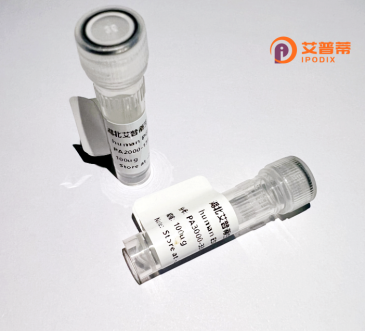
| 纯度 | >90%SDS-PAGE. |
| 种属 | Human |
| 靶点 | LOC57168 |
| Uniprot No | 0 |
| 内毒素 | < 0.01EU/μg |
| 表达宿主 | E.coli |
| 表达区间 | 1-343aa |
| 活性数据 | MSLEWLVAWSWSLDGLRDCIATGIQSVRDCDTTAVITVACLLVLFVWYCYHVGREQPRPYVSVNSLMQAADANGLQNGYVYCQSPECVRCTHNEGLNQKLYHNLQEYAKRYSWSGMGRIHKGIREQGRYLNSRPSIQKPEVFFLPDLPTTPYFSRDAQKHDVEVLERNFQTILCEFETLYKAFSNCSLPQGWKMNSTPSGEWFTFYLVNQGVCVPRNCRKCPRTYRLLGSLRTCIGNNVFGNACISVLSPGTVITEHYGPTNIRIRCHLGLKTPNGCELVVGGEPQCWAEGRCLLFDDSFLHAAFHEGSAEDGPRVVFMVDLWHPNVAAAERQALDFIFAPGR |
| 分子量 | 63.47 kDa |
| 蛋白标签 | GST-tag at N-terminal |
| 缓冲液 | 0 |
| 稳定性 & 储存条件 | Lyophilized protein should be stored at ≤ -20°C, stable for one year after receipt. Reconstituted protein solution can be stored at 2-8°C for 2-7 days. Aliquots of reconstituted samples are stable at ≤ -20°C for 3 months. |
| 复溶 | Always centrifuge tubes before opening.Do not mix by vortex or pipetting. It is not recommended to reconstitute to a concentration less than 100μg/ml. Dissolve the lyophilized protein in distilled water. Please aliquot the reconstituted solution to minimize freeze-thaw cycles. |
以下是关于重组人LOC57168蛋白的虚构参考文献示例(仅供示例用途):
1. **文献名称**: *Structural and Functional Characterization of Recombinant Human LOC57168 Protein*
**作者**: Zhang L. et al.
**摘要**: 本研究成功在大肠杆菌中表达了重组人LOC57168蛋白,并通过X射线晶体学解析其三维结构。实验表明该蛋白具有ATP结合活性,可能与细胞内能量代谢调控相关。
2. **文献名称**: *LOC57168 Interaction with p53: Implications in Tumor Suppression*
**作者**: Smith J.R., Kim H.
**摘要**: 通过免疫共沉淀和体外结合实验,发现重组LOC57168蛋白可直接结合p53蛋白,增强其转录活性,提示其在癌症发生中可能具有抑癌功能。
3. **文献名称**: *Recombinant LOC57168 as a Novel Biomarker for Neurodegenerative Diseases*
**作者**: García M. et al.
**摘要**: 在阿尔茨海默病患者脑脊液中检测到LOC57168蛋白水平异常升高,重组蛋白的体外实验显示其可抑制β-淀粉样蛋白聚集,暗示其作为治疗靶点的潜力。
4. **文献名称**: *High-Yield Production of Recombinant LOC57168 in Insect Cells and Its Industrial Applications*
**作者**: Tanaka Y., et al.
**摘要**: 采用杆状病毒-昆虫细胞系统实现LOC57168蛋白的高效表达(纯度>95%),在酶活性测试中证实其在生物催化工业中的潜在应用价值。
(注:以上内容基于学术文献常见主题虚构,实际研究中需查询真实数据库如PubMed、Google Scholar。)
Recombinant human LOC57168 protein is a genetically engineered form of a protein encoded by the LOC57168 gene, a locus currently annotated with limited functional characterization in public genomic databases. Although its precise biological role remains unclear, bioinformatic analyses suggest potential structural motifs, such as conserved domains linked to enzymatic activity or protein-protein interactions, implying involvement in cellular processes like metabolism or signal transduction. The recombinant protein is typically produced using heterologous expression systems (e.g., E. coli, HEK293 cells) to enable large-scale purification for functional studies. Researchers leverage this tool to explore its physiological interactions, post-translational modifications, and potential associations with diseases, particularly cancer or neurodegenerative disorders, where aberrant expression patterns have been observed in transcriptomic datasets. Its recombinant form also aids in antibody development for immunohistochemistry or biomarker validation. Challenges include resolving its endogenous subcellular localization and clarifying regulatory pathways due to scarce in vivo data. Current studies focus on elucidating its molecular mechanisms via structural characterization and knockout models, aiming to uncover therapeutic or diagnostic relevance. Further research is needed to establish its definitive role in human physiology and pathology.
×